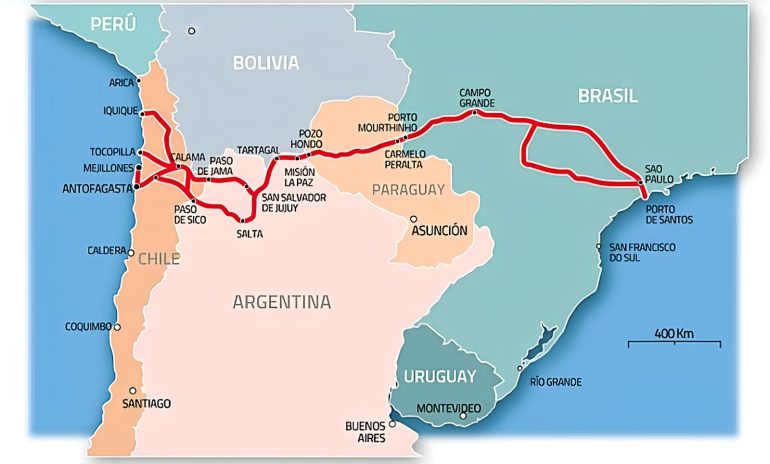With the Bioceanic Bridge, connecting Paraguay and Brazil, nearing completion, The Asunción Times dives deeper into the monumental Bioceanic Corridor project. The new bridge, spanning the Paraguay River between Carmelo Peralta and Porto Murtinho, connects Brazil and Paraguay to facilitate trade and transport along the Bioceanic Corridor. A multimodal transportation route spanning over 2,000 kilometres across South America.
The Bioceanic Corridor, also named Capricorn Bioceanic Corridor, connects the Atlantic port of Santos in Brazil to the Pacific ports of northern Chile through Paraguay and Argentina. The project seeks to promote trade, transport, and economic growth by establishing a continuous transit route across the continent. Its primary objective to connect the Atlantic and Pacific Oceans is to provide quicker access to Asian markets, with completion expected by 2026.
The long route through the Drake Passage
For centuries, if not millennia, nations have sought ways to make travel shorter, swifter, and economically viable. Presently, in the southern and more central regions of South America, it remains quicker to transport goods from the Atlantic to the Pacific side by ship through the Drake Passage, one of the world’s most formidable navigable areas, rather than by land routes.
Alternatively, merchants can pass through the Panama Canal, but this lengthens the journey, thereby increasing costs, and the area is more prone to hurricanes. Companies engaged in global trade are less inclined to accept the losses compared to potential gains.
Whilst numerous routes connect the eastern and western coasts, none have been truly straightforward until now. This is a primary reason for the development of the Bioceanic Corridor. Which, besides enhancing existing routes, involves constructing new railway lines for transport, and refurbishing or establishing ports.
Trajectory of the Bioceanic Corridor
The Bioceanic Corridor begins in Santos, Brazil, and connects Antofagasta and Iquique, Chile. The initial version of the project was intended to pass through Bolivia and Peru, but it was considered too hazardous due to the Amazon Rainforest, the Pantanal, and the high altitudes of the mountains in the designated area. Additionally, the project could have been harmful to the indigenous populations in the region.
The Brazilian segment of the route links to Campo Grande, Mato Grosso do Sul. The Bioceanic Corridor’s final city in Brazil is Porto Murtinho, where the Bioceanic Bridge is under construction to connect with the Paraguayan city of Puerto Capitán Carmelo Peralta. The bridge is nearing completion, with over 80% finished.
From there, the Bioceanic Corridor follows Paraguayan Route 15, passing near the Mennonite communities of Filadelfía and Lomo Plata via Mariscal Estigarribia, to reach Pozo Hondo, the last city in Paraguay. On the western side, the bridge connecting Pozo Hondo and Misión La Paz, Argentina, already exists. The Paraguayan section spans approximately 530 kilometres, or 330 miles. From Misión La Paz, it will connect with Salta, still in Argentina, and reach the Chilean coast.
Boosting Paraguay’s economy
Three areas in Paraguay will economically benefit more than others due to the Bioceanic Corridor: the frontier towns of Puerto Capitán Carmelo Peralta and Pozo Hondo, as well as the city of Mariscal Estigarribia.
Puerto Capitán Carmelo Peralta in Paraguay has a population of approximately 4,400. Across the border in Brazil’s Porto Murtinho, around 15,000 people reside. Its first international business was the Anglo-Argentine “The River Plate Quebracho Company Sociedad Anónima”. In the 1940s, they were extracting willow-leaf red quebracho.
Although business has declined due to the region’s isolation, it is reviving due to the construction of the bridge north of the city. Currently, the locality primarily relies on ecotourism, as Puerto Capitán Carmelo Peralta is branded “La Entrada al Pantanal.” This city is also one of the last navigable stops coming from Paraguay’s capital Asunción.
Bioceanic Corridor’s impact on connectivity
Pozo Hondo is situated at the border with Argentina. Together with Misión La Paz de Santa Victoria Este, the city has a combined population of only 2,500. Although it is not densely populated, its proximity to the Bolivian border makes it appealing for companies looking to establish cross-border trade. Electricity, telephone services, and internet arrived in the region in April 2021, partly due to the construction of the Bioceanic Corridor.
Mariscal Estigarribia is located in the centre of Northern Paraguay, in the Chaco area. The district has a population of approximately 13,000, whilst the city proper has around 3,000 residents. It was originally established as a military city, now converted to civilian use. Mariscal Estigarribia features several churches that attract visitors and is situated very close to Filadelfía and Lomo Plata. Owing to its strategic location at the junction of Bioceanic Route 15 and Transchaco Route 9, it is poised to become a significant industrial hub.


